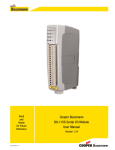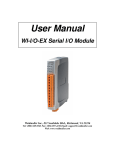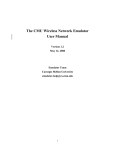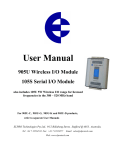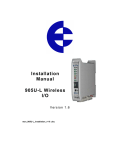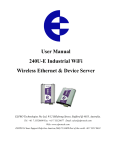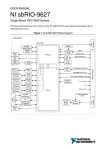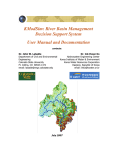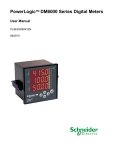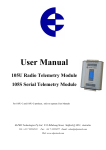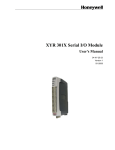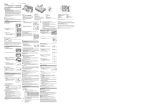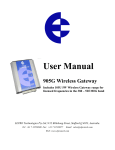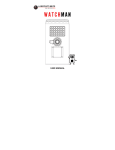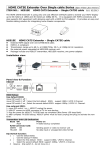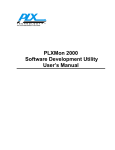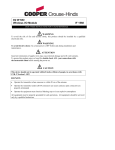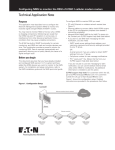Download 115S Serial I/O Module User Manual
Transcript
115S Serial I/O Module User Manual ELPRO Technologies Pty Ltd, 9/12 Billabong Street, Stafford Q 4053, Australia. Tel: +61 7 33528600 Fax: +61 7 33528677 Email: [email protected] Web: www.elprotech.com 115S Serial I/O Module User Manual Thank you for your selection of the 115S Serial I/O Module. We trust it will give you many years of valuable service. ATTENTION! Incorrect termination of supply wires may cause internal damage and will void warranty. To ensure your 115S product enjoys a long life, Double check ALL your connections with the User Manual, before turning the power on. All equipment must be properly grounded for safe operation. All equipment should be serviced only by a qualified technician. Important Notice ELPRO products are designed to be used in industrial environments, by experienced industrial engineering personnel with adequate knowledge of safety design considerations. These products should not be used in non-industrial applications, or life-support systems, without consulting ELPRO Technologies first. Installation and Operating Instructions: The Expansion I/O modules are to be installed by trained personnel / licensed electricians only and installation must be carried out in accordance with the instructions listed in the Installation Guide and applicable local regulatory codes. The units are intended for Restricted Access Locations. The Expansion I/O modules are intended to be installed in a final enclosure, rated IP54, before use outdoors. The Equipment shall be powered using an external Listed Power Supply with LPS outputs or a Class 2 Power Supply. Hazardous Location Notices: This device complies with Ex nA IIC T5 Gc -40C <= Ta <= + 60C WARNING: EXPLOSION HAZARD. Do not disconnect equipment unless power has been switched off or the area is known to be non-hazardous. Page 2 June 2011 115S Serial I/O Module User Manual Limited Lifetime Warranty, Disclaimer and Limitation of Remedies ELPRO products are warranted to be free from manufacturing defects for the “serviceable lifetime” of the product. The “serviceable lifetime” is limited to the availability of electronic components. If the serviceable life is reached in less than three years following the original purchase from ELPRO, ELPRO will replace the product with an equivalent product if an equivalent product is available. This warranty does not extend to: failures caused by operation of the equipment outside the particular product's specification, or use of the module not in accordance with this User Manual, or abuse, misuse, neglect or damage by external causes, or repairs, alterations, or modifications undertaken other than by an authorized Service Agent. ELPRO’s liability under this warranty is limited to the replacement or repair of the product. This warranty is in lieu of and exclusive of all other warranties. This warranty does not indemnify the purchaser of products for any consequential claim for damages or loss of operations or profits and ELPRO is not liable for any consequential damages or loss of operations or profits resulting from the use of these products. ELPRO is not liable for damages, losses, costs, injury or harm incurred as a consequence of any representations, warranties or conditions made by ELPRO or its representatives or by any other party, except as expressed solely in this document. man_115S_1.15.docx Page 3 115S Serial I/O Module User Manual CONTENTS 1 OVERVIEW................................................................................................................ 5 1.1 MODULE TYPES AND FEATURES .................................................................................... 7 1.1.1 Digital inputs / outputs ........................................................................................ 7 1.1.2 Pulsed outputs.....................................................................................................7 1.1.3 Pulsed inputs.......................................................................................................8 1.1.4 Analog inputs .....................................................................................................8 1.1.5 Analog outputs.................................................................................................... 9 1.1.6 Communications ............................................................................................... 10 2 INSTALLATION...................................................................................................... 11 2.1 GENERAL INSTALLATION ............................................................................................ 11 2.1.1 Power Connection............................................................................................. 11 2.1.2 Address Switches .............................................................................................. 12 2.2 SIGNAL CONNECTIONS ................................................................................................ 13 2.2.1 Digital Inputs (and Pulsed Inputs) ..................................................................... 13 2.2.2 Digital Outputs (and Pulsed Outputs) ................................................................ 14 2.2.3 Analog Inputs ................................................................................................... 14 2.2.4 Analog Outputs ................................................................................................. 18 3 CONFIGURATION ................................................................................................. 21 3.1 3.2 4 ELPRO EXPANSION I/O CONFIGURATION. .................................................................. 21 MODBUS SLAVE CONFIGURATION ............................................................................ 23 HARDWARE CONFIGURATION ........................................................................ 24 4.1 CONNECTING TO THE 115S MODULE ........................................................................... 24 4.2 CONFIGURATION COMMON TO ALL MODULES .............................................................. 25 4.2.1 Communications ............................................................................................... 25 4.2.2 Modbus Output Timeout on Comms fail ........................................................... 26 4.2.3 Configurable ACK Timeout .............................................................................. 27 4.2.4 Pulsed outputs................................................................................................... 28 4.3 115S-11 CONFIGURATION ........................................................................................... 29 4.3.1 Pulsed Inputs .................................................................................................... 29 4.4 115S-12 CONFIGURATION ........................................................................................... 30 4.4.1 Voltage input .................................................................................................... 30 4.4.2 Current input..................................................................................................... 33 4.5 115S-13 CONFIGURATION ........................................................................................... 36 4.5.1 Voltage output .................................................................................................. 36 4.5.2 Current output................................................................................................... 38 5 OPERATION ............................................................................................................ 40 5.1 5.2 5.3 5.4 115S-11 MODULE ........................................................................................................ 40 115S-12 MODULE ........................................................................................................ 41 115S-13 MODULE ........................................................................................................ 43 HEXADECIMAL REPRESENTATION OF VOLTAGE AND CURRENT LEVELS ........................ 45 APPENDIX A. MODBUS ADDRESS MAP ................................................................. 46 A.1. 115S-11 ......................................................................................................................... 46 A.2. 115S-12 ......................................................................................................................... 48 A.3. 115S-13 ......................................................................................................................... 50 APPENDIX B. MODBUS FUNCTIONALITY ............................................................ 52 APPENDIX C. COMMS RECOVERY ......................................................................... 53 Page 4 June 2011 115S Serial I/O Module User Manual APPENDIX D. SPECIFICATIONS .............................................................................. 55 APPENDIX E. RS232 WIRING .................................................................................... 57 1 Overview The ELPRO 115S modules are designed to provide I/O expansion for other ELPRO products like 105U and 905U modules. The 115S modules support the ELPRO E-Series protocol, and communicate serially via RS232 or RS485. Configuration is done via the ELPRO E-Series configuration utility. The 115S modules also support MODBUS protocol. They may be used as a MODBUS slave with any 3rd-party MODBUS device, or with the ELPRO 105U-G or 905U-G modules using MODBUS. They support both MODBUS ASCII protocol, and serial unsigned MODBUS RTU, also known as “MODBUS binary”. The Modbus slave address of the 115S is selected via two rotary switches on the bottom panel of the case. All 115S models provide digital inputs and outputs. Specific models provide analog inputs or analog outputs. Pulsed inputs and pulsed outputs are also available. Several modules may be connected to one master, allowing any combination of I/O types. Figure 1-1 shows a diagram of a 115S module with parts labelled. man_115S_1.15.docx Page 5 115S Serial I/O Module User Manual Status LEDs RS485 and power connector Address switches RS485 termination switch I/O connector RS232 configuration connector DIN rail mount Power OK Transmit Receive Analog configuration access panel Figure 1-1: 115S unit with significant parts labeled. Two ports allow configuration and communications on the 115S. The RS232 port is intended for configuration. The RS485 port allows the unit to be in a multi-drop configuration. Overvoltage protection and supply monitoring is provided to minimize the risk of failure due to faulty connections or supply surges. Page 6 June 2011 115S Serial I/O Module User Manual 1.1 Module types and features The module types and I/O are summarised in Table 1-1. 115S -11 -12 -13 Digital inputs/outputs 16 8 8 Pulse outputs 8 8 8 Pulse inputs 4 - - Analog inputs - 8 - Analog outputs - - 8 Table 1-1: Summary of 115S module types and I/O. 1.1.1 Digital inputs / outputs Each digital I/O channel on the 115S modules can act as either an input or an output. The input/output direction does not need to be user configured. Digital inputs are suitable for voltage-free contacts, or NPN-transistor switch devices. Digital outputs are open-collector transistor outputs, able to switch loads up to 30VDC, 200mA. If you have wired an input/output channel as an input, it is recommended that you do not write values to it as an output. No electrical damage will occur if you attempt to use a channel wired as an input as an output, or vice-versa, however the I/O system will not operate correctly. We recommend that the required digital inputs be assigned consecutively from channel 1. Then use the remaining channels as digital outputs. 1.1.2 Pulsed outputs The first eight digital channels on each 115S module can be used as pulse outputs. The maximum output frequency is 50Hz. A pulse output on the 115S will output the number of pulses equal to the register value sent by the master. When the master sends a new register value, the 115S will output additional pulses until the output count is the same as the new value. Three register values are associated with creating each pulsed output: • The Count keeps a tally of how many pulses have been output - this is a 16-bit register and overflows to 0. • The Target is set by the master, and is the trigger for pulses to be created. The digital channel outputs pulses until the Count value reaches the Target value. If the Target register is set to 0, the pulses stop and the Count register is cleared. man_115S_1.15.docx Page 7 115S Serial I/O Module • User Manual The Update Time is the interval in which the 115S expects to receive updates to the Target value. The module will output enough pulses for the Count to reach the Target within the update time. The output pulse rate is determined by the update time, and the difference between the count and the target. If the calculated pulse rate is more than the maximum rate (50Hz), the 115S will output pulses at the maximum rate. At the end of the update time, the count value will be less than the target. The 115S will then calculate the new required pulse rate for the next update period, based on the difference between Count and Target values. If the calculated pulse rate is greater than around three times the maximum rate, pulses are not output. The Count value will be set to the value of the Target without any pulses output. Pulses will be output again when the calculated pulse rate falls within the maximum possible rate. 1.1.3 Pulsed inputs The first four digital channels on the 115S-11 module can be used as pulsed inputs. The maximum input pulse frequency is 1 KHz. The pulse input channel calculates two register variables, each of which can be read by the Modbus master. • • The Pulse Count is a count of the pulses detected on the channel since the 115S powered up. The pulse input counts are 32-bit values (2 x 16-bit registers, a low and a high register), and wrap around to zero on overflow. The Pulse Rate is a measure of the rate of pulses detected on the channel. The pulse rate value is decimal 16,384 (hex 4000) for zero rate and decimal 49,152 (hex C000) for the maximum rate configured by the user. These zero and maximum values are the same as 0% and 100% used for analog values. (See section 5.4 for hex to decimal conversion.) The maximum pulse input rate is set during configuration. The value is in pulses per minute and is limited to 60000 (1 KHz), the maximum rate capable of the module. 1.1.4 Analog inputs The analog inputs on the 115S-12 can be connected as either grounded single-ended inputs or as floating differential inputs. The 115S-12 has eight grounded inputs or four floating inputs. • Grounded single-ended inputs connect between the AIN terminal and the GND terminal. • Floating differential inputs each take up two terminals. There are four differential pairs on the 115S-12: [AIN1-AIN2], [AIN3-AIN4], [AIN5-AIN6], [AIN7-AIN8]. For Page 8 June 2011 115S Serial I/O Module User Manual example, the first input is connected to terminals AIN1 (positive) and AIN2 (negative). The two types of input cannot be mixed - all inputs must be either “grounded” or “floating”. Inputs can also be selected as mA current, or voltage input - all inputs must be the same, either all current or all voltage. The scale of each analog input is chosen during hardware configuration, with scale options as follows: Voltage input scale options: [0 to 5V], [0 to 10V], [1 to 5V] Current input scale options: [0 to 10mA], [0 to 20mA], [4 to 20mA] For compatibility with E-Series modules, 4-20mA current is recommended. See section 4.4 for more information on compatibility. The values on the analog input are decimal 16,384 (hex 4000) for minimum signal (0%) and decimal 49,152 (hex C000) for maximum (100%). The analog channel will measure over-scale, up to 150% which will have value 65,536 (hex FFFF). For 4-20mA signals, the channel will measure under-scale down to 0mA which has a value of 8,192 (hex 2000). (See section 5.4 for hex to decimal conversion.) The 115S-12 provides a 24V analog loop supply (“ALS”) for powering analog loops. 1.1.5 Analog outputs The 115S-13 has eight analog output channels and can be configured to output voltage or current. For current signals, “source” or “sink” can be selected. The scale of each analog output is specified during configuration, with scale options as follows: Voltage output scale options: [0 to 5V], [0 to 10V], [1 to 5V] Current output scale options: [0 to 10mA], [0 to 20mA], [4 to 20mA], source or sink • • • Voltage outputs are measured with respect to the ground terminal. Current source outputs are measured with respect to the ground terminal. Current sink outputs are measured with respect to the 24V “ALS” terminal. Writing to the output register by the master produces the analog output. Minimum to maximum signals (0 – 100%) are produced by register values from decimal 16,384 to 49,152 (hex 4000 - C000). (See section 5.4 for hex to decimal conversion.) The analog channel can output over-scale, up to 150% corresponding to register value 65,536 (hex FFFF). For 4-20mA signals, the channel can output under-scale down to 0mA from a register value of 8,192 (hex 2000) or less. Note that the over-scale output is limited by the maximum levels capable of the 115S module (12V or 24mA). man_115S_1.15.docx Page 9 115S Serial I/O Module User Manual 1.1.6 Communications The 115S modules have two communication ports: RS232 and RS485. The RS485 port communicates using E-Series protocol. Both ports support Modbus protocol. The RS232 port is intended for configuration. The RS485 port is intended for normal operation and can be used in a multi-drop setup. There are two address switches on the base of the module. When the switches are set within the range 01-99, the module uses Modbus protocol on the RS485 port, with the Modbus address defined by the switches. Setting both address switches to 00 configures the module to use E-Series protocol on the RS485 port. Whenever these address switches are changed the unit should be reset by disconnecting power. Note - When configured for E-Series protocol the maximum number of expansion modules per radio is 10 as each module requires 3 addresses. When using E-Series protocol, the port settings are fixed at 9600 baud, 8 data bits, no parity, 1 stop bit. The Modbus communications settings are configurable as follows: Modbus type: RTU, ASCII with 8 data bits, ASCII with 7 data bits. (Note that the configuration software only supports Modbus RTU. A Modbus Master can select ASCII protocol by writing to the appropriate register. See Appendix A.) Baud rate: 1200, 2400, 4800, 9600, 14400, 19200, 28800, 38400, 57600, 76800, 115200 Parity: none, odd, even Stop bits: 1 or 2. The modules are fitted with a termination switch for the RS485. Set this switch only on the last module in a multi-drop RS485 configuration. The ELPRO E-Series software is used to configure the 115S modules as part of an E_Series network. The hardware set-up for items such as expected pulse rates and analog signals is also available through this software. When used as a Modbus-only device, stand-alone configuration software (cfg_115S_Vx.xx.exe) is available to set up the modules. All required software may be downloaded from the ELPRO website. Page 10 June 2011 115S Serial I/O Module User Manual 2 Installation All connections to the module should be SELV only. Normal 110/220/240V mains supply should not be connected to any input terminal of the module. 2.1 General installation Several 115S modules may be connected to one Master / E-Series Radio via RS485 multi-drop connection as shown in Figure 2-1. Ensure there are good connections between the 115S units and the master and a separate Earth connected to the ‘GND’ terminal on the front Terminal block of each module. 2.5 sqmm / 12 gauge earth wire is recommended. Figure 2-1: Several 115S units connected to a master. 2.1.1 Power Connection The 115S modules require a 10.8-30 VDC ** power supply. This is supplied to the 4-way connector, shown in Figure 2-2. ** Model Dependent. Check rear label for actual operating voltages BA- + Figure 2-2: Power and RS485 connector. Connect 10.8-30 VDC to + and earth to -. Connect RS485 to B and A. man_115S_1.15.docx Page 11 115S Serial I/O Module User Manual 2.1.2 Address Switches The address switches are found on the bottom panel of the module, as shown in Figure 2-3. If you are using the 115S module with other ELPRO E-Series modules (ELPRO 105 and 905- modules), the address switches must be set to “00”. This enables ELPRO protocol mode and assigns 3 serial addresses to each module. If you are using a Modbus Master device, ensure each 115S connected to the same Modbus master has a unique Modbus address. Note that the module must be reset after changing the address switches. You can connect to an ELPRO 105U-G-MD1 or 905U-G-MD1 Module using either MODBUS protocol or ELPRO protocol. ELPRO protocol is easier to set up, and we recommend using this protocol for most applications. x10 x1 Figure 2-3: Address switches. The address shown is 01. Connect the RS485 B and A wires to the 4-way connector shown previously in Figure 2-2. An RS485 termination switch is provided. Terminate the last 115S module in the multi-drop setup as shown in Figure 2-4. Up = terminate Down = unterminated ON RS485 termination switch. Master A B 115S A B 115S A B 115S A B Termination switch up (terminated) 120Ω Figure 2-4: RS485 multi-drop connection and termination (only use external termination for the master if it does not have internal termination). Page 12 June 2011 115S Serial I/O Module 2.2 User Manual Signal Connections All connections to the module should be SELV only. Normal 110/220/240V mains supply should not be connected to any input terminal of the module. 2.2.1 Digital Inputs (and Pulsed Inputs) The 115S-11 supports 16 digital signals, and the 115S-12 and 115S-13 support 8 digital signals. Additionally, digital inputs DIO1-4 on the 115S-11 operate as pulse inputs. Digital output signals share the same terminals as the Digital input signals, marked DIO18, and DIO1-16 on the 115S-11 module. A digital input is activated by connecting to EARTH, either by voltage-free contact or by a transistor switch. Refer to Figure 2-5: 115S Module V+ V+ DIO1 Voltage-free contact DIO2 Transistor switch device EARTH V- Figure 2-5: Connection of digital inputs. man_115S_1.15.docx Page 13 115S Serial I/O Module User Manual 2.2.2 Digital Outputs (and Pulsed Outputs) The 115S-11 supports up to 16 digital outputs, shared with the digital input function on the same terminals. The 115S-12 and 115S-13 both provide 8 digital output signals. These signals are marked DIO1-8, and DIO1-16 for the 115S-11. On all 115S modules, DIO1-8 can also operate as pulsed outputs. When active, digital outputs provide a transistor switch to EARTH. To connect a digital output, refer to the diagram in Figure 2-6. A bypass diode is recommended to protect against switching surges for inductive loads such as relay coils. 115S Module DIO1 DIO2 DC Load + Max 30VDC 0.2A V- EARTH _ Figure 2-6: Connection of digital outputs. Note that digital outputs will only switch DC circuits, with maximum voltage 30VDC. 2.2.3 Analog Inputs The 115S-12 provides eight grounded single-ended or four floating differential analog inputs. These provide measurement of voltage signals (0-10V) or current (0-20 mA) signals. An internal 24V analog loop supply (ALS) is generated for current loops. Refer to Section 4.4 for detail on configuring single-ended, differential, current-mode or voltage mode inputs. 2.2.3.1 Grounded Single-Ended mA Inputs Single-ended current inputs allow twice as many inputs as the differential mode. This mode is useful when the sensor loop can be grounded to the 115S module. Devices may also be powered by the 24V supplied by the 115S. Refer to Figure 2-7: Page 14 June 2011 115S Serial I/O Module User Manual Loop powered sensor - + 115S-12 Module ALS +24V AIN1 AIN2 Externally powered sensor + - AGND V- Figure 2-7: Connection for single-ended current inputs. Transducers may be externally powered or powered by the 115S +24V loop supply. Note: - The module is configured at the factory for this type of input - To change the input configuration, refer to section 4.4 WARNING ! Ensure correct DIP switch positions AND software configuration has been completed for each analogue input BEFORE connecting external signals to the 115S-12 module. man_115S_1.15.docx Page 15 115S Serial I/O Module User Manual 2.2.3.2 Floating Differential Mode mA Inputs Differential mode current inputs should be used when measuring a current loop which cannot be connected to earth or ground. This allows the input to be connected anywhere in the current loop. Common mode voltage can be up to 27VDC. Up to four loops can be connected, to terminal pairs [AIN1-AIN2], [AIN3-AIN4], [AIN5-AIN6], [AIN7-AIN8] - the former terminal is +ve and the latter –ve. The diagram in Figure 2-8 indicates how to connect devices for differential mode current inputs. 115S-12 Module ALS +24V Loop powered sensor Power supply + AIN1 AIN2 AIN3 + - AIN4 Externally powered sensor AGND V- Figure 2-8: Connections for differential current inputs. Note: - The module configuration needs to be changed for this type of input - To change the input configuration, refer to section 4.4 WARNING ! Ensure correct DIP switch positions AND software configuration has been completed for each analogue input BEFORE connecting external signals to the 115S-12 module. Page 16 June 2011 115S Serial I/O Module User Manual 2.2.3.3 Floating Differential Voltage Inputs Differential voltage inputs allow a voltage to be measured when it cannot be referenced to earth or ground. The diagram in Figure 2-9 shows how to connect differential voltage inputs. The module has a 27V common mode input range. 115S-12 Module ALS +24V AIN1 + AIN2 - AIN3 + AIN4 Sensors with voltage signals AGND V- Figure 2-9: Connection for differential voltage input mode. Note: - The module configuration needs to be changed for this type of input - To change the input configuration, refer to section 4.4 WARNING ! Ensure correct DIP switch positions AND software configuration has been completed for each analogue input BEFORE connecting external signals to the 115S-12 module. 2.2.3.4 Single-ended Voltage Input Single-ended voltage inputs allow twice as many inputs as differential mode. This mode is useful when one end of the input voltage can be connected to the ground of the 115S module. Figure 2-10 shows connections for single-ended voltage input. man_115S_1.15.docx Page 17 115S Serial I/O Module User Manual 115S-12 Module ALS +24V Sensor with voltage signal AIN1 AIN2 + AGND V- Figure 2-10: Connection for single-ended voltage input. Note: - The module configuration needs to be changed for this type of input - To change the input configuration, refer to section 4.4 WARNING ! Ensure correct DIP switch positions AND software configuration has been completed for each analogue input BEFORE connecting external signals to the 115S-12 module. 2.2.4 Analog Outputs The 115S-13 provides eight analog outputs. These may be configured as voltage or current outputs. The current output may be selected as “sink” or “source” current. Refer to Section 4.5 for detail on configuring analog outputs. 2.2.4.1 Current Output Current output mode may be configured for current source or current sink. Figure 2-11 shows the connections for current source mode. Figure 2-12 shows the connections for current sink. Page 18 June 2011 115S Serial I/O Module User Manual 115S-13 Module ALS +24V AI AOT1 AOT2 + AGND V- COM PLC - Figure 2-11: Connection for current source output. Note: - The module is configured at the factory for this type of output connection - To change the input configuration, refer to section 4.5 115S-13 Module AI+ ALS +24V AOT1 - + AI- PLC AOT2 V- AGND Figure 2-12: Connection for current sink output. Note: - The hardware configuration needs to be changed for this type of output connection - To change the hardware configuration, refer to section 4.5 man_115S_1.15.docx Page 19 115S Serial I/O Module User Manual 2.2.4.2 Voltage Output Voltage output mode produces a voltage referenced to the module’s AGND. Figure 2-13 shows the connection for voltage output configuration. 115S-13 Module PLC VOLTAGE INPUT ALS +24V AI AOT1 AOT2 + V- AGND COM - Figure 2-13: Connection for voltage output configuration. Page 20 June 2011 115S Serial I/O Module User Manual 3 Configuration The 115S serial expansion modules can be configured as expansion I/O for the ELPRO radio modules. When configured like this the module communicates using standard ELPRO protocol which works on a Change of State concept like all other ELPRO radio modules. The module can also be configured as a Standard MODBUS Slave device which operates by responding to poll messages from a MODBUS Master (DCS, SCADA, PLC, Etc). 3.1 ELPRO Expansion I/O configuration. Use the ELPRO Configuration utility to configure the 115S module to communicate to 105U and 905U radio modules. - Ensure the Address switches are set to “00” for ELPRO protocol mode. Refer to section 2.1.2 for details on setting the address switches. The ELPRO Configuration utility allows you to configure systems consisting of a mixture of ELPRO Module types. The software can be downloaded from the ELPRO web-site, or from the ELPRO Product CD included with your device. 115S expansion I/O module can only be added to the software via the ‘Serial Units’ branch of a radio module, see Figure 3.1 below. If using the module as a standalone serial device (without radios) you will need to add a dummy radio module to the software and then add all serial module to this dummy modules ‘Serial Units’ branch. - Refer to your radio module user manual for an explanation on how to create the radio module configuration. Once you have created the new radio module configuration, or a radio module was already present you can add a serial module. Select the radio module that you want to connect the 115S serial module to, and select the “Serial Units” item. Select “Add a new Serial Unit” to create the new configuration, or select “Load a New Serial Unit” to load the configuration from an existing module. See Figure 3-1 & 3.2 below. man_115S_1.15.docx Page 21 115S Serial I/O Module User Manual Figure 3-1: Configuration of 115S modules using ELPRO Configuration Utility. When you select “Add a new Serial Unit” you will need to select the unit type. Select the correct module type here. Figure 3-2: Select the unit type. Finally, you will be prompted to select the module address. You can choose to allow the configuration software to select an unused address for you, or you can select the module address manually. - Serial Module address must be in the range 96 to 127. - Every serial module that is connected to the same radio module needs a separate address. - You can use the same address on two different serial modules if they are connected to different radio modules. Note – When using modules as Elpro Expansion I/O each module will be assigned 3 addresses. Once you have added the new module you can configure I/O mappings the same way you would for the older 105 series modules or a radio module. For more information on configuring ELPRO ESeries modules using the E-Config software, refer to the 105-1 or 905-1 user manual. Page 22 Figure 3-3: Select unit address. June 2011 115S Serial I/O Module User Manual 3.2 MODBUS Slave Configuration If configured as a MODBUS Slave the module will need to have a unique Slave address, see section 2.1.2 “Address Switches” above for details on how this is done. The Address selected will be the address that the MODBUS Master needs to poll to gather data. The module also has a number of internal registers that hold the I/O values, status, etc. These register are polled by the MODBUS Master using standard commands that Read/Write values to or from the device. When the Modbus Master Polls the Slave is does so using a Modbus Command and an I/O location. This Modbus command will varies depending on whether they are Inputs / Outputs and Analog / Digital values Example • To read a Digital Input on the module an “02: Input Status” command is used and the Modbus address will be in the range 10001 – 19999 • To read an Analog input on the module an “04: Input Register” Command is used and the Modbus address will be in the range 30001 – 39999. • To write to a Digital output (Turn it on) you need to use a “01: Coil Status” Command and the Modbus address location will be 0001 – 9999 • To Write to an Analog output you will need to use an “03: Holding Register” command and the Modbus Address will be in the range 40001 – 49999 See Appendix A “Modbus address map” for the I/O registers locations. Note: all Analog values are 16 bit unsigned integers. We recommend using Wintech’s Modscan and Modsim which are low cost Modbus Master and Modbus Slave simulators to help diagnose any Read/Write addressing issues. www.win-tech.com man_115S_1.15.docx Page 23 115S Serial I/O Module User Manual 4 Hardware Configuration Hardware Set-up allows the 115S hardware function to be adjusted to suit the application. To configure the hardware settings, you need: - Access to the DIP switches under the Analog Configuration Panel (refer Figure 1-1: 115S unit with significant parts labeled.) - Configuration Software to run on your PC. Configuration of the 115S modules is performed by either the dedicated 115S configuration software (cfg_115S_Vx.xx.exe), or by the ELPRO E-Series configuration software (from the Utilities / Advanced - SXM menu). The software is available from ELPRO’s Product CD or web page 4.1 Connecting to the 115S module To use the configuration software, perform the following steps: • Connect the 115S to the PC COM port with a standard serial cable (straight-through, DB9 female to DB9 male. See Appendix for wiring.) • Set the address switches to 00 • Supply power to the 115S via the “+” and “-” terminals on the bottom of the module (10.8-30 VDC **). ** Model Dependent. Check rear label for actual operating voltages • Start the configuration software on your PC or laptop (cfg_115S_Vx.xx.exe) Figure 4-1: Main configuration screen. Page 24 June 2011 115S Serial I/O Module • • • User Manual Set the “Port” setting to match the computer com port you have connected to. Set the “Slave Address” to match the address switch setting of the 115S. If you are using address “00” for ELPRO Protocol, set the Slave Address to 100. Set the communications parameters. The default communications parameters are: Baud rate: 9600 Parity: NONE Stop bits: 1 Click the button labelled Connect to 115S. If you are unable to communicate with the 115S, refer to Appendix C: Comms Recovery. If connection has been successful, several folder tabs will become available, depending on the module type. The panel on the right-hand side of the form shows the 115S detected and its settings. 4.2 Configuration common to all modules 4.2.1 Communications Select the Comms folder tab. This page allows you to change the communications settings of the 115S. These settings are applied to both the RS-232 configuration port and to the RS-485 Modbus interface port. Choose the required settings, then click Set comms. You will need to power off / on the 115S for the new settings to take effect. Figure 4-2: Communications configuration screen. man_115S_1.15.docx Page 25 115S Serial I/O Module User Manual 4.2.2 Modbus Output Timeout on Comms fail The module when being used as a Modbus Slave device has an output reset on comms fail feature. This means the outputs are turned off after a configured timeout if the module doesn’t receive any Modbus polls to itself. Note: The Modbus Output Timeout feature is available in Firmware version 2.02 and above. To set the Modbus Output reset time use the configuration software (V1.09 and above) and under the “Comms” tab you will see a “Modbus Output Timeout”. Select the appropriate time and then press the “Set Comms” button and then resetting the module. See Figure 4-2 above Note that you will need to change the connection settings on the “Connect” page, and reconnect to the 115S. Maximum Output timeout is 34 minute 57 seconds. Selecting 00:00 minutes and seconds will disable the outputs resetting. Be aware the “Modbus Output Timeout” must be greater than the Modbus Master Poll time or you will see the outputs reset before the next poll. Generally it is good practice to configure the reset time to two or three times the Modbus poll time so as to ensure accurate comms fail indication. The “Modbus Output Timeout” can also be configured by the Modbus Master by writing into register 204 in units of 32 msec. E.g. A0 hex would be 5.12 seconds, 3A9 hex would be 30 seconds, and 249F would be 5 minutes. The module then needs to be reset for the settings to take effect. Also the module must be operating in MODBUS mode, otherwise the reset outputs feature is disabled, so the modules address must be set to something other than “00”. If using the modules in ELPRO E-Series mode the Outputs also have a reset feature that can be configured within the E-Series Configuration Utility. Page 26 June 2011 115S Serial I/O Module User Manual 4.2.3 Configurable ACK Timeout All communications between Elpro devices using Elpro Protocol is two way communications. The initiating module sends a message to an end device and expects to get a response within a given time period, this response is called an acknowledgement. If this acknowledgment is not received in the allotted timeframe the message is retried up to 4 times with a random 0-5 seconds delay between each retry. If all retries are not acknowledged then a communications fail can be flagged. Typically the 115S expansion I/O modules are used with 105U/905U I/O radios and the longer Acknowledge Timeouts are not required. If using the modules with Elpro modems or third party devices were the acknowledgement is likely to take longer than 5 seconds then a configurable Ack time can be implemented to overcome these timing issues. E.g. Communication path may have a number of repeaters or be going through a network with longer timeframes (GSM or Ethernet Networks) Note: The Configurable Acknowledge timeout is only available in firmware version 2.04 and greater. The configurable Ack timeout allows the wait time of this response to be extended by adjusting a register shown in the table below. Address 40205 Description Configurable Ack timeout The Ack timeout is configurable from 32msec to 34 minutes 57 seconds, see examples below. Ack Timeout will be added to the default random 0-5 sec retry time. The factory value for the Ack timeout will be 0 which will use the default 0-5 second staggered timeout. Decimal Value 1 16 31 62 100 156 312 469 625 1000 man_115S_1.15.docx Timeout 32msec 500msec 1 Sec 2 Sec 3.2 sec 5 Sec 10 Sec 15 Sec 20 Sec 32 Sec Decimal Value 1875 3750 7500 9375 18750 28125 37500 46875 56250 65535 Timeout 1 Min 2 Min 4 Min 5 min 10 Min 15 Min 20 Min 25 Min 30 Min 34 Min 57 Sec Page 27 115S Serial I/O Module User Manual 4.2.4 Pulsed outputs Choose the folder tab labeled Pulsed Outputs Setup, as shown in Figure 4-3. Figure 4-3: Pulsed outputs setup page for a 115S-11. The pulsed outputs are available on all models. Clicking the button Read from 115S will read the pulse out update times from the 115S and display them on the form. The Pulse Out Update Times should be set to the approximate interval at which the 115S will receive updates to its pulse out target register. The pulse output circuitry will attempt to generate pulses at a rate that will reach the target pulse count within the update time. For example, if the Modbus master unit is configured to send the register value for the pulse output channel every 1 minute, then the Update Time should be set to 1 minute. The maximum allowed pulse out update time is 34 minutes 57 seconds. Set the update times for each channel in hours, minutes, and seconds. An update time of zero will never produce any pulses. After the update times have been set, click the Save Update Times button. The pulse output feature can be tested on the Check folder tab (refer section 5). Page 28 June 2011 115S Serial I/O Module 4.3 User Manual 115S-11 configuration 4.3.1 Pulsed Inputs Choose the Pulse Inputs Setup page, as shown in Figure 4-4. Figure 4-4: Pulse inputs setup. Only available on a 115S-11 module. Clicking the Read from 115S button reads the existing maximum pulse rate settings from the 115S and displays them on the form. If pulse rate is to be used, the maximum pulse input rate must be set. The pulse rate value is calculated as a fraction of the maximum pulse input rate. Specify the maximum pulse input rate in pulses per minute. The highest allowable pulse input rate is 60000 pulses per minute, or 1kHz. Once the maximum pulse rates are specified, click the Save Max Rates button to save the data to the 115S module. The pulse input feature can be tested on the DIO Check page (refer section 5.1). man_115S_1.15.docx Page 29 115S Serial I/O Module 4.4 User Manual 115S-12 configuration 4.4.1 Voltage input Voltage inputs may be selected in the scales 0 to 5V, 0 to 10V, or 1 to 5V. For each scale, the minimum to maximum signal levels are represented by 4000 hex to C000 hex. Table 4-1 shows how the 115S-12 voltage readings translate to outputs in other ELPRO products. 115S-12 Voltage scale 0 to 5V 0 to 10V 1 to 5V 115S-12 Input voltage (V) 0 5 0 10 0 1 5 105-G Register value (hex) 4000 C000 4000 C000 2000 4000 C000 105-1 Output current (mA) 4 20 4 20 0.5* 4 20 105-3 Output current (mA) 4 20 4 20 0 4 20 Table 4-1: Compatibility of 115S-12 voltage inputs with other ELPRO products. * Reduced accuracy for less than 4mA in 105-1. Page 30 June 2011 115S Serial I/O Module User Manual 4.4.1.1 Single-ended voltage input If the 115S-12 is to measure voltage with respect to ground, choose the Single-ended voltage input page, as shown in Figure 4-5. Remove the access panel from the front of the 115S-12 case to gain access to the dip switches. Replace the access panel after setting the switches. Set the switches according to the picture shown. The unit should be orientated with the 20-way connector towards you. Figure 4-5: Setup page for single-ended voltage input. Once the dip switches on the unit are set, tick the checkbox on the form, and click Save configuration. Check the 115S Detected panel to ensure that the analog mode has been updated (to Voltage, single-ended). Clicking Read from 115S will read the scales out of the unit (if any) and display them in the scales grid. Note that the dip switches should be set correctly for this result to be relevant. Choose the desired scale for each channel in the Scale box. Click the Save scales to 115S button, and check that the scales are updated in the 115S Detected panel. man_115S_1.15.docx Page 31 115S Serial I/O Module User Manual 4.4.1.2 Differential voltage input The 115S-12 can be configured to measure differential voltage. Neighbouring channels serve as reference voltages in this mode. The four differential pairs are: AIN1-AIN2, AIN3-AIN4, AIN5-AIN6, and AIN7-AIN8. Note: If mapping Differential Voltage inputs using the Elpro E-Series Configuration software only map the Odd inputs. E.g. AIN1 for the first Differential input, AIN3 for the second, AIN5 for the third and AIN7 for the fourth. If using Modbus all registers can be read but only the odd registers holds the values, i.e. 30001 for AIN1-AIN2, 30003 for AIN3-AIN4, 30005 for AIN5- AIN6 and 30007 for AIN7-AIN8. Choose the page to configure the 115S-12 for differential voltage input, as shown in Figure 4-6. Remove the access panel from the front of the 115S-12 case to gain access to the dip switches. Replace the access panel after setting the switches. Set the switches according to the picture shown. The unit should be orientated with the 20-way connector towards you. Figure 4-6: Setup page for differential voltage input. Page 32 June 2011 115S Serial I/O Module User Manual Once the dip switches on the unit are set, tick the checkbox on the form, and click Save configuration. Check the 115S Detected panel to ensure that the analog mode has been updated (to Voltage, differential). Clicking Read from 115S will read the scales out of the unit (if any) and display them in the scales grid. Note that the dip switches should be set correctly for this result to be relevant. Choose the desired scale for each channel in the Scale box. Click the Save scales to 115S button, and check that the scales are updated in the 115S Detected panel. 4.4.2 Current input Current inputs may be selected in the scales 0 to 10mA, 0 to 20mA, or 4 to 20mA. For each scale, the minimum to maximum signal levels are represented by 4000 hex to C000 hex. Table 4-2 shows how the 115S-12 current readings translate to outputs in other ELPRO products. 115S-12 Current scale 0 to 10mA 0 to 20mA 4 to 20mA 115S-12 Input current (mA) 0 10 0 20 0 4 20 105-G Register value (hex) 4000 C000 4000 C000 2000 4000 C000 105-1 Output current (mA) 4 20 4 20 0.5* 4 20 105-3 Output current (mA) 4 20 4 20 0 4 20 Table 4-2: Compatibility of 115S-12 current inputs with other ELPRO products. * Reduced accuracy for less than 4mA in 105-1. man_115S_1.15.docx Page 33 115S Serial I/O Module User Manual 4.4.2.1 Single-ended current input The 115S-12 can also measure current input. To measure current with respect to ground, choose the Single-ended current input page, as shown in Figure 4-7. Remove the access panel from the front of the 115S-12 case to gain access to the dip switches. Replace the access panel after setting the switches. Set the switches according to the picture shown. The unit should be orientated with the 20-way connector towards you. Figure 4-7: Setup page for single-ended current input. Once the dip switches on the unit are set, tick the checkbox on the form, and click Save configuration. Check the 115S Detected panel to ensure that the analog mode has been updated (to Current, single-ended). Clicking Read from 115S will read the scales out of the unit (if any) and display them in the scales grid. Note that the dip switches should be set correctly for this result to be relevant. Choose the desired scale for each channel in the Scale box. Click the Save scales to 115S button, and check that the scales are updated in the 115S Detected panel. Page 34 June 2011 115S Serial I/O Module User Manual 4.4.2.2 Differential current input The 115S-12 can be configured to measure differential current. The differential pairs are: AIN1-AIN2, AIN3-AIN4, AIN5-AIN6, and AIN7-AIN8. To use this configuration, choose the differential current input page, as shown in Figure 4-8. Note: If mapping Differential Analog inputs using the Elpro E-Series Configuration software map only the Odd inputs. E.g. AIN1 for the first Differential input, AIN3 for the second, AIN5 for the third and AIN7 for the fourth. If using Modbus all registers can be read but only the odd registers holds the values, i.e. 30001 for AIN1-AIN2, 30003 for AIN3-AIN4, 30005 for AIN5- AIN6 and 30007 for AIN7-AIN8. Remove the access panel from the front of the 115S-12 case to gain access to the dip switches. Replace the access panel after setting the switches. Set the switches according to the picture shown. The unit should be orientated with the 20-way connector towards you. Figure 4-8: Setup page for differential current configuration. man_115S_1.15.docx Page 35 115S Serial I/O Module User Manual Once the dip switches on the unit are set, tick the checkbox on the form, and click Save configuration. Check the 115S Detected panel to ensure that the analog mode has been updated (to Current, differential). Clicking Read from 115S will read the scales out of the unit (if any) and display them in the scales grid. Note that the dip switches should be set correctly for this result to be relevant. Choose the desired scale for each channel in the Scale box. Click the Save scales to 115S button, and check that the scales are updated in the 115S Detected panel. 4.5 115S-13 configuration 4.5.1 Voltage output Voltage outputs may be selected in the scales 0 to 5V, 0 to 10V, or 1 to 5V. For each scale, the minimum to maximum signal levels are represented by 4000 hex to C000 hex. Table 4-3 shows how signals from other ELPRO products translate to 115S-13 voltage levels. 115S-13 Voltage scale 0 to 5V 0 to 10V 1 to 5V 105-1 Input current (mA) 4 20 4 20 N/A* 2* 4 20 105-2 Input current (mA) 4 20 4 20 0 2 4 20 105-G Register value (hex) 4000 C000 4000 C000 2000 3000 4000 C000 115S-13 Output voltage (V) 0 5 0 10 0 0.5 1 5 Table 4-3: Compatibility of other ELPRO products with 115S-13 voltage outputs. * Reduced accuracy for less than 4mA in 105-1. Page 36 June 2011 115S Serial I/O Module User Manual To configure the 115S-13 for voltage output, select the page as shown in Figure 4-9. Remove the access panel from the front of the 115S-12 case to gain access to the dip switches. Replace the access panel after setting the switches. Set the switches according to the picture shown. The unit should be orientated with the 20-way connector towards you. Figure 4-9: Voltage output setup page. Once the dip switches on the unit are set, tick the checkbox on the form, and click Save configuration. Check the 115S Detected panel to ensure that the analog mode has been updated (to Voltage). Clicking Read from 115S will read the scales out of the unit (if any) and display them in the scales grid. Note that the dip switches should be set correctly for this result to be relevant. Choose the desired scale for each channel in the Scale box. Click the Save scales to 115S button, and check that the scales are updated in the 115S Detected panel. man_115S_1.15.docx Page 37 115S Serial I/O Module User Manual 4.5.2 Current output Current outputs may be selected in the scales 0 to 10mA, 0 to 20mA, or 4 to 20mA. For each scale, the minimum to maximum signal levels are represented by 4000 hex to C000 hex. Table 4-4 shows how signals from other ELPRO products translate to 115S-13 current levels. 115S-13 Current scale 0 to 10mA 0 to 20mA 4 to 20mA 105-1 Input current (mA) 4 20 4 20 N/A* 2* 4 20 105-2 Input current (mA) 4 20 4 20 0 2 4 20 105-G Register value (hex) 4000 C000 4000 C000 2000 3000 4000 C000 115S-13 Output current (mA) 0 10 0 20 0 2 4 20 Table 4-4: Compatibility of other ELPRO products with 115S-13 voltage outputs. * Reduced accuracy for less than 4mA in 105-1. Page 38 June 2011 115S Serial I/O Module User Manual To configure the 115S-13 for current output, select the page as shown in Figure 4-10. Remove the access panel from the front of the 115S-12 case to gain access to the dip switches. Replace the access panel after setting the switches. Set the switches according to the picture shown. The unit should be orientated with the 20-way connector towards you. Figure 4-10: Current output setup page. Once the dip switches on the unit are set, tick the checkbox on the form, and click Save configuration. Check the 115S Detected panel to ensure that the analog mode has been updated (to Current). Clicking Read from 115S will read the scales out of the unit (if any) and display them in the scales grid. Note that the dip switches should be set correctly for this result to be relevant. Choose the desired scale for each channel in the Scale box. Click the Save scales to 115S button, and check that the scales are updated in the 115S Detected panel. man_115S_1.15.docx Page 39 115S Serial I/O Module User Manual 5 Operation 5.1 115S-11 module The I/O terminal block for the 115S-11 is shown in Figure 5-1. DIO DIO DIO DIO DIO DIO DIO DIO DIO DIO DIO DIO DIO DIO DIO DIO 10 11 12 13 14 15 16 Earth Earth 1 2 3 4 5 6 7 8 Earth Earth 9 Figure 5-1: I/O terminal block for 115S-11. Pulse inputs coincide with DIO terminals 1-4. Pulse outputs coincide with DIO terminals 1-8. The operation of the digital I/O may be confirmed using the configuration software. Start the software as described in section 4, and choose the DIO Check page as shown in Figure 5-2. Figure 5-2: Check the operation of the 115S-11 module using the DIO Check page. Page 40 June 2011 115S Serial I/O Module User Manual Test the digital outputs by setting the select-buttons to ON or OFF - this will force the DO to the selected state. Digital inputs are reflected in the software by blacking (ON) or greying (OFF) of the associated label in the Digital Inputs column. The pulsed input count values are shown, as well as the pulse rate. The rate can be viewed in decimal or hexadecimal and represents a fraction of the maximum pulse rate, where hex 4000 is 0% and hex C000 is 100% of the maximum pulse rate. The pulse output count values are also shown. The pulse out target may be set by clicking the Edit Targets button. Pulses will be produced until the count reaches the target. 5.2 115S-12 module The I/O terminal block for the 115S-12 is shown in Figure 5-3. DIO DIO DIO DIO DIO DIO DIO DIO ALS AI+1 AI-1 AI+2 AI-2 AI+3 AI-3 AI+4 AI-4 A ALS 1 2 3 4 5 6 7 8 Earth +24 AI 1 AI 2 AI 3 AI 4 AI 5 AI 6 AI 7 AI 8 GND +24 Figure 5-3: I/O terminal block for 115S-12. Pulse outputs coincide with DIO terminals 1-8. The operation of the 115S-12 may be confirmed using the configuration software. Start the software as described in section 4, and choose the AIN Check page as shown in Figure 5-4. man_115S_1.15.docx Page 41 115S Serial I/O Module User Manual Figure 5-4: Check the operation of the 115S-12 module with the AIN Check page. Test the digital outputs by setting the select-buttons to ON or OFF - this will force the DO to the selected state. Digital inputs are reflected in the software by blacking (ON) or greying (OFF) of the associated label in the Digital Inputs column. The pulse output count values are also shown. The pulse out target may be set by clicking the Edit Targets button. Pulses will be produced until the count reaches the target. The analog inputs can be viewed in decimal or hexadecimal and represents a fraction of the analog signal, where hex 4000 is 0% and hex C000 is 100%. In differential configuration, only the value of the first channel in the differential pair shows the quantity being measured. The second channel of each differential pair should be ignored. Page 42 June 2011 115S Serial I/O Module User Manual 5.3 115S-13 module The I/O terminal block for the 115S-13 is shown in Figure 5-5. DIO DIO DIO DIO DIO DIO DIO DIO ALS AOT AOT AOT AOT AOT AOT AOT AOT A ALS 1 2 3 4 5 6 7 8 Earth +24 1 2 3 4 5 6 7 8 GND +24 Figure 5-5: I/O terminal block for 115S-13. Pulse outputs coincide with DIO terminals 1-8. The operation of the 115S-13 may be confirmed using the configuration software. Start the software as described in chapter 4, and choose the AOT Check page. Figure 5-6: Check the operation of the 115S-13 module using the AOT Check page. man_115S_1.15.docx Page 43 115S Serial I/O Module User Manual Test the digital outputs by setting the select-buttons to ON or OFF - this will force the DO to the selected state. Digital inputs are reflected in the software by blacking (ON) or greying (OFF) of the associated label in the Digital Inputs column. The pulse output count values are also shown. The pulse out target may be set by clicking the Edit Targets button. Pulses will be produced until the count reaches the target. The analog outputs can be viewed in decimal or hexadecimal and represents a fraction of the analog signal, where hex 4000 is 0% and hex C000 is 100%. The analog output values can be set by the user for testing, and the output signal measured to confirm the analog operation. If you are using hexadecimal values (which is the easiest) ensure the $ symbol precedes the value to denote a hex number. Page 44 June 2011 115S Serial I/O Module User Manual 5.4 Hexadecimal representation of voltage and current levels The voltage and current levels are represented as a fraction of the configured scale. 4000 hex represents the minimum level in the scale, and C000 hex represents the maximum level in the scale. Levels and their hex representation are summarised in Table 5-1 for easy reference. Hex value 0000 0800 1000 1800 2000 2800 3000 3800 4000 4800 5000 5800 6000 6800 7000 7800 8000 8800 9000 9800 A000 A800 B000 B800 C000 C800 D000 D800 E000 E800 F000 Percent 0.00% 3.13% 6.25% 9.38% 12.50% 15.63% 18.75% 21.88% 25.00% 28.13% 31.25% 34.38% 37.50% 40.63% 43.75% 46.88% 50.00% 53.13% 56.25% 59.38% 62.50% 65.63% 68.75% 71.88% 75.00% 78.13% 81.25% 84.38% 87.50% 90.63% 93.75% Dec value 0 2048 4096 6144 8192 10240 12288 14336 16384 18432 20480 22528 24576 26624 28672 30720 32768 34816 36864 38912 40960 43008 45056 47104 49152 51200 53248 55296 57344 59392 61440 Voltage scale Current scale 0-5V 0-10V 1-5V 0-10mA 0-20mA 4-20mA N/A N/A N/A N/A N/A N/A N/A N/A 0.00 0.31 0.63 0.94 1.25 1.56 1.88 2.19 2.50 2.81 3.13 3.44 3.75 4.06 4.38 4.69 5.00 5.31 5.63 5.94 6.25 6.56 6.88 N/A N/A N/A N/A N/A N/A N/A N/A 0.00 0.63 1.25 1.88 2.50 3.13 3.75 4.38 5.00 5.63 6.25 6.88 7.50 8.13 8.75 9.38 10.00 10.63 11.25 11.88 12.50 13.13 13.75 N/A N/A N/A N/A 0.00 0.25 0.50 0.75 1.00 1.25 1.50 1.75 2.00 2.25 2.50 2.75 3.00 3.25 3.50 3.75 4.00 4.25 4.50 4.75 5.00 5.25 5.50 5.75 6.00 6.25 6.50 N/A N/A N/A N/A N/A N/A N/A N/A 0.00 0.63 1.25 1.88 2.50 3.13 3.75 4.38 5.00 5.63 6.25 6.88 7.50 8.13 8.75 9.38 10.00 10.63 11.25 11.88 12.50 13.13 13.75 N/A N/A N/A N/A N/A N/A N/A N/A 0.00 1.25 2.50 3.75 5.00 6.25 7.50 8.75 10.00 11.25 12.50 13.75 15.00 16.25 17.50 18.75 20.00 21.25 22.50 23.75 N/A N/A N/A N/A N/A N/A N/A 0.00 1.00 2.00 3.00 4.00 5.00 6.00 7.00 8.00 9.00 10.00 11.00 12.00 13.00 14.00 15.00 16.00 17.00 18.00 19.00 20.00 21.00 22.00 23.00 24.00 N/A N/A Table 5-1: Hex representation of voltage and current levels. man_115S_1.15.docx Page 45 115S Serial I/O Module User Manual Appendix A. Modbus address map A.1. 115S-11 Data Digital input 1 Digital input 2 Digital input 3 Digital input 4 Digital input 5 Digital input 6 Digital input 7 Digital input 8 Digital input 9 Digital input 10 Digital input 11 Digital input 12 Digital input 13 Digital input 14 Digital input 15 Digital input 16 Digital output 1 Digital output 2 Digital output 3 Digital output 4 Digital output 5 Digital output 6 Digital output 7 Digital output 8 Digital output 9 Digital output 10 Digital output 11 Digital output 12 Digital output 13 Digital output 14 Digital output 15 Digital output 16 Pulse input count 1 Pulse input count 2 Pulse input count 3 Pulse input count 4 Pulse input rate 1 Pulse input rate 2 Pulse input rate 3 Page 46 Modbus I/O Type Input status Input status Input status Input status Input status Input status Input status Input status Input status Input status Input status Input status Input status Input status Input status Input status Coil status Coil status Coil status Coil status Coil status Coil status Coil status Coil status Coil status Coil status Coil status Coil status Coil status Coil status Coil status Coil status Input registers Input registers Input registers Input registers Input registers Input registers Input registers Modbus Addresses 10001 10002 10003 10004 10005 10006 10007 10008 10009 10010 10011 10012 10013 10014 10015 10016 00001 00002 00003 00004 00005 00006 00007 00008 00009 00010 00011 00012 00013 00014 00015 00016 30017 – 30018 30019 – 30020 30021 – 30022 30023 – 30024 30001 30002 30003 June 2011 115S Serial I/O Module Data Pulse input rate 4 Maximum input pulse rate 1 Maximum input pulse rate 2 Maximum input pulse rate 3 Maximum input pulse rate 4 Pulse output count 1 Pulse output count 2 Pulse output count 3 Pulse output count 4 Pulse output count 5 Pulse output count 6 Pulse output count 7 Pulse output count 8 Pulse output target 1 Pulse output target 2 Pulse output target 3 Pulse output target 4 Pulse output target 5 Pulse output target 6 Pulse output target 7 Pulse output target 8 Modbus Output Timeout Pulse out update time 1 Pulse out update time 2 Pulse out update time 3 Pulse out update time 4 Pulse out update time 5 Pulse out update time 6 Pulse out update time 7 Pulse out update time 8 Module supply voltage* Serial port transmission mode Serial port baud rate Serial port parity and stop bit Modbus Comms Fail Timeout! ELPRO ACK Timeout! Module Firmware version% User Manual Modbus I/O Type Input registers Input registers Input registers Input registers Input registers Input registers Input registers Input registers Input registers Input registers Input registers Input registers Input registers Holding registers Holding registers Holding registers Holding registers Holding registers Holding registers Holding registers Holding registers Holding registers Input registers Input registers Input registers Input registers Input registers Input registers Input registers Input registers Input registers Input registers Input registers Input registers Input registers Input registers Input Register Modbus Addresses 30004 30101 30102 30103 30104 30009 30010 30011 30012 30013 30014 30015 30016 40009 40010 40011 40012 40013 40014 40015 40016 40204 30109 30110 30111 30112 30113 30114 30115 30116 30033 30201 30202 30203 30204 30205 30801 * 0x4000 = 8V; 0xC000 = 40V (Firmware earlier than 2.00 is 0x4000 = 8V; 0xC000 = 16V Timeout values in 32mSec increments % 0x0204 = Ver 2.04 ! man_115S_1.15.docx Page 47 115S Serial I/O Module A.2. 115S-12 Data Digital input 1 Digital input 2 Digital input 3 Digital input 4 Digital input 5 Digital input 6 Digital input 7 Digital input 8 Digital output 1 Digital output 2 Digital output 3 Digital output 4 Digital output 5 Digital output 6 Digital output 7 Digital output 8 Pulse output count 1 Pulse output count 2 Pulse output count 3 Pulse output count 4 Pulse output count 5 Pulse output count 6 Pulse output count 7 Pulse output count 8 Pulse output target 1 Pulse output target 2 Pulse output target 3 Pulse output target 4 Pulse output target 5 Pulse output target 6 Pulse output target 7 Pulse output target 8 Modbus Output Timeout Pulse out update time 1 Pulse out update time 2 Pulse out update time 3 Pulse out update time 4 Pulse out update time 5 Pulse out update time 6 Pulse out update time 7 Pulse out update time 8 Page 48 User Manual Modbus I/O Type Input status Input status Input status Input status Input status Input status Input status Input status Coil status Coil status Coil status Coil status Coil status Coil status Coil status Coil status Input registers Input registers Input registers Input registers Input registers Input registers Input registers Input registers Holding registers Holding registers Holding registers Holding registers Holding registers Holding registers Holding registers Holding registers Holding registers Input registers Input registers Input registers Input registers Input registers Input registers Input registers Input registers Modbus Addresses 10001 10002 10003 10004 10005 10006 10007 10008 00001 00002 00003 00004 00005 00006 00007 00008 30009 30010 30011 30012 30013 30014 30015 30016 40009 40010 40011 40012 40013 40014 40015 40016 40204 30109 30110 30111 30112 30113 30114 30115 30116 June 2011 115S Serial I/O Module Data Analog inputs 1 Analog inputs 2 Analog inputs 3 Analog inputs 4 Analog inputs 5 Analog inputs 6 Analog inputs 7 Analog inputs 8 Module supply voltage* Analog supply voltage (24V)+ Serial port transmission mode Serial port baud rate Serial port parity and stop bit Modbus Comms Fail Timeout! ELPRO ACK Timeout! Module Firmware version% User Manual Modbus I/O Type Input registers Input registers Input registers Input registers Input registers Input registers Input registers Input registers Input registers Input registers Input registers Input registers Input registers Input registers Input registers Input Register Modbus Addresses 30001 30002 30003 30004 30005 30006 30007 30008 30033 30034 30201 30202 30203 30204 30205 30801 * 0x4000 = 8V; 0xC000 = 40V (Firmware earlier than 2.00 is 0x4000 = 8V; 0xC000 = 16V 0x4000 =12V; 0xC000 = 36V ! Timeout values in 32mSec increments % 0x0204 = Ver 2.04 + Note: If using Differential Voltage or Current inputs, only the odd inputs should be used, i.e. AIN1 for the first input, AIN3 for the second, AIN5 for the third and AIN7 for the fourth. man_115S_1.15.docx Page 49 115S Serial I/O Module A.3. 115S-13 Data Digital input 1 Digital input 2 Digital input 3 Digital input 4 Digital input 5 Digital input 6 Digital input 7 Digital input 8 Digital output 1 Digital output 2 Digital output 3 Digital output 4 Digital output 5 Digital output 6 Digital output 7 Digital output 8 Pulse output count 1 Pulse output count 2 Pulse output count 3 Pulse output count 4 Pulse output count 5 Pulse output count 6 Pulse output count 7 Pulse output count 8 Pulse output target 1 Pulse output target 2 Pulse output target 3 Pulse output target 4 Pulse output target 5 Pulse output target 6 Pulse output target 7 Pulse output target 8 Modbus Output Timeout Pulse out update time 1 Pulse out update time 2 Pulse out update time 3 Pulse out update time 4 Pulse out update time 5 Pulse out update time 6 Pulse out update time 7 Pulse out update time 8 Analog outputs 1 Page 50 User Manual Modbus I/O Type Input status Input status Input status Input status Input status Input status Input status Input status Coil status Coil status Coil status Coil status Coil status Coil status Coil status Coil status Input registers Input registers Input registers Input registers Input registers Input registers Input registers Input registers Holding registers Holding registers Holding registers Holding registers Holding registers Holding registers Holding registers Holding registers Holding registers Input registers Input registers Input registers Input registers Input registers Input registers Input registers Input registers Holding registers Modbus Addresses 10001 10002 10003 10004 10005 10006 10007 10008 00001 00002 00003 00004 00005 00006 00007 00008 30009 30010 30011 30012 30013 30014 30015 30016 40009 40010 40011 40012 40013 40014 40015 40016 40204 30109 30110 30111 30112 30113 30114 30115 30116 40001 June 2011 115S Serial I/O Module Data Analog outputs 2 Analog outputs 3 Analog outputs 4 Analog outputs 5 Analog outputs 6 Analog outputs 7 Analog outputs 8 Module supply voltage* Analog supply voltage (28V) + Serial port transmission mode Serial port baud rate Serial port parity and stop bit Modbus Comms Fail Timeout! ELPRO ACK Timeout! Module Firmware version% User Manual Modbus I/O Type Holding registers Holding registers Holding registers Holding registers Holding registers Holding registers Holding registers Input registers Input registers Input registers Input registers Input registers Input registers Input registers Input Register Modbus Addresses 40002 40003 40004 40005 40006 40007 40008 30033 30034 30201 30202 30203 30204 30205 30801 * 0x4000 = 8V; 0xC000 = 40V (Firmware earlier than 2.00 is 0x4000 = 8V; 0xC000 = 16V 0x4000 =12V; 0xC000 = 36V ! Timeout values in 32mSec increments % 0x0204 = Ver 2.04 + man_115S_1.15.docx Page 51 115S Serial I/O Module User Manual Appendix B. Modbus Functionality Table B-1 specifies the maximum query and response data parameters for the 115S modules. See the Gould Modbus Protocol Reference guide (PI-MBUS 300 Rev B) for more detail. Function code 1,2 Description Maximum Data Size Read coil / input status 1160 coils / inputs 3 Read holding (output) registers 145 registers 4 Read input registers 145 registers 5 Force single coil 1 coil 6 Set single register 1 register 7 Read exception status 8 coils 8 Loopback test N/A 9,10 NOT SUPPORTED NOT SUPPORTED 11 Communications event counter N/A 12-14 NOT SUPPORTED NOT SUPPORTED 15 Force multiple coils 1160 coils 16 Set multiple registers 145 registers 17-255 NOT SUPPORTED NOT SUPPORTED Table B-1: Supported Modbus functions and limitations for 115S modules. Page 52 June 2011 115S Serial I/O Module User Manual Appendix C. Comms Recovery If the communications setting of the 115S has been forgotten or mistakenly set, there is a way of recovering serial communications with the 115S. 115S firmware versions 1.04 and earlier require ModScan to do this. With later firmware versions, this can be done using the configuration software, cfg_115S_Vx.xx.exe. Procedure for recovering communications with recent firmware (V1.05 and later): 1. Set the Modbus address switches to 00. This fixes the communications setting to Modbus RTU, 9600 baud, no parity, and one stop bit. 2. Connect a standard (straight-through) RS232 cable to the module and the PC. 3. Start the configuration software, cfg_115S_Vx.xx.exe. 4. Set the slave address to 100. 5. Ensure the comms settings are 9600 baud, no parity, one stop bit. 6. Click Connect to 115S 7. The module should connect successfully. 8. Choose the Comms page and change the settings to the desired parameters. 9. If the module did not connect successfully, try the steps listed below for using ModScan. Procedure for recovering communications with firmware V1.04 and earlier: 1. Set the Modbus address switches to 00. This fixes the communications setting to those specified in step 6. 2. Connect the RS232 port to the PC and start ModScan. 3. Supply power to the 115S. 4. In ModScan, set the following - Address: 0201 - Length: 3 - Device ID: 100 - Modbus Point Type: Holding register 5. Click Connection / Connect. 6. Choose the appropriate COM port. Also choose - Baud rate: 9600 - Word length: 8 - Parity: none - Stop bits: 1 7. Click Protocol Selection. Choose STANDARD ASCII for Transmission mode. Click OK, OK. 8. ModScan should connect to the module with no errors. 9. The registers displayed in ModScan represent the serial port settings that are used when the address switches are set to other than 00, as follows: Address 40201 Description Serial port transmission mode man_115S_1.15.docx Page 53 115S Serial I/O Module 40202 40203 User Manual Serial port baud rate Serial port parity and stop bit 10. Use the tables below to work out the current communications settings, or write to the registers using ModScan to change the settings to the desired values. Note that the module transmission mode should be set to Modbus RTU. Modbus address 40201, serial port transmission mode: Setting Register Value Modbus RTU 0x0101 Modbus ASCII, 8 data bits 0x0201 Modbus ASCII, 7 data bits 0x0202 Modbus address 40202, serial port baud rate: Setting Register Value 1200 0x000C 2400 0x0018 4800 0x0030 9600 0x0060 14400 0x0090 19200 0x00C0 28800 0x0120 38400 0x0180 57600 0x0240 76800 0x0300 115200 0x0480 Modbus address 40203, serial port parity and stop bit: Parity Setting Register’s High Byte Value None 0x00 Odd 0x11 Even 0x22 Stop-bit Setting 1 stop bit 2 stop bits Register’s Low Byte Value 0x11 0x22 11. Once the new comms setting are correct, be sure to change the address switches back to a non-zero setting for normal operation. Page 54 June 2011 115S Serial I/O Module User Manual Appendix D. Specifications EMC Approval Operating temperature range Power supply Supply current (idle 13.8V) -11 -12 -13 Supply current for I/O per digital input per digital output per analog input per analog output Loop supply Loop supply max current RS232 port RS485 port Modbus protocol Transmission modes Baud rates Parity Stop bits Slave address man_115S_1.15.docx EN 55024:1998 EN 61000-3-2: 2002 EN 61000-3-3: 2002 EN 55022: 1998 FCC Part 15 -40 to +60 deg C 10.8 – 30.0 VDC 13.8V / 24VDC nom Model Dependent. Check rear label for actual operating voltages 100mA 100mA 120mA 13mA 13mA 50mA 50mA 24V nominal * If using 24V loop supply * Loop supply will follow 115S-xx power supply voltage above 24V input. 115S-12 : 270mA 115S-13 : 160mA Modbus protocol Modbus protocol ELPRO E-Series protocol Modbus ASCII 8 data bits Modbus ASCII 7 data bits** Modbus RTU 1200; 2400; 4800; 9600; 14,400; 19,200; 28,800; 38,400; 57,600; 76,800; 115,200 Odd, even, none 1, 2 Modbus = 01-99 ** If no parity, use 2 stop bits. If using parity, use 1 stop bit. Elpro = 96 - 127. Note: Each module requires 3 addresses meaning the maximum number of serial modules per radio is 10. Page 55 115S Serial I/O Module User Manual Default settings If slave address = 0 Digital inputs On-state voltage Wetting current Max pulse input rate Minimum pulse width Max pulse input count <2.1VDC 5mA 1kHz 0.5mS 4294967295 (32-bit) Digital outputs Output voltage range Output current max Max pulse output rate Max pulse output count 0-30VDC 200mA 50Hz 65535 Analog Inputs Input voltage range Voltage resolution Input current range Current resolution Input impedance (voltage) Input impedance (current) Common mode voltage range Calibrated accuracy Analog Outputs Output voltage range Voltage resolution Output current range Current resolution Calibrated accuracy Modbus RTU, 9600, N, 1 0-12V 16 bits 0-24mA 16 bits 100k 100ohm 27VDC 0.10% 0-12V 12 bits 0-24mA 12 bits 0.10% Total output current 160mA Table D-1: 115S Specifications. 115S Digital inputs/outputs Pulse outputs Pulse inputs Analog inputs Analog outputs -11 16 8 4 - -12 8 8 8 - -13 8 8 8 Table D-2: 115S module types and I/O. Page 56 June 2011 115S Serial I/O Module User Manual Appendix E. RS232 Wiring The RS232 connection to the 115S modules requires a standard straight-through serial cable (modem cable). The wiring is shown in Figure E-1. 115S DB9 MALE PC DB9 FEMALE Figure E-1: Wiring for RS232 cable for PC-115S communications. man_115S_1.15.docx Page 57

























































